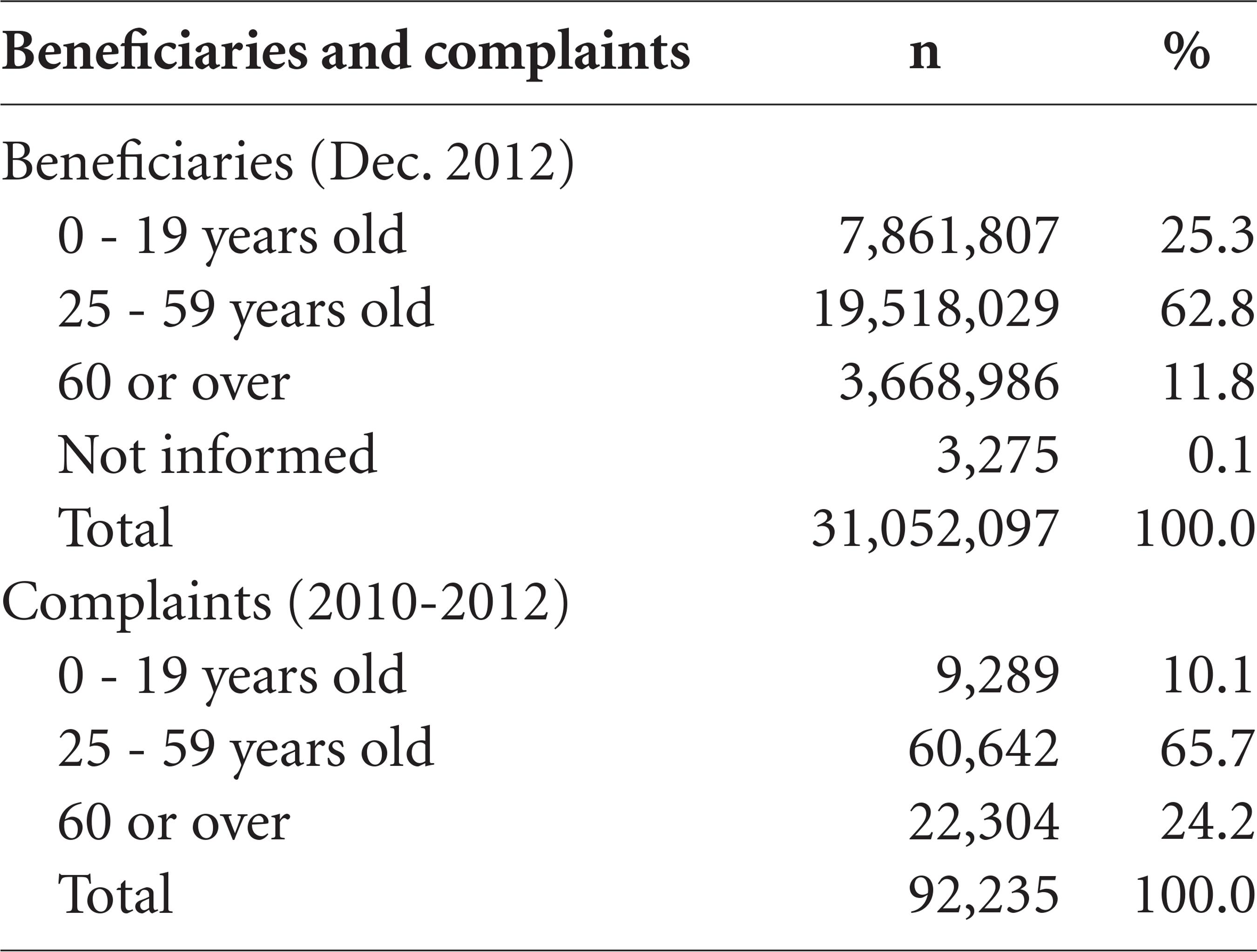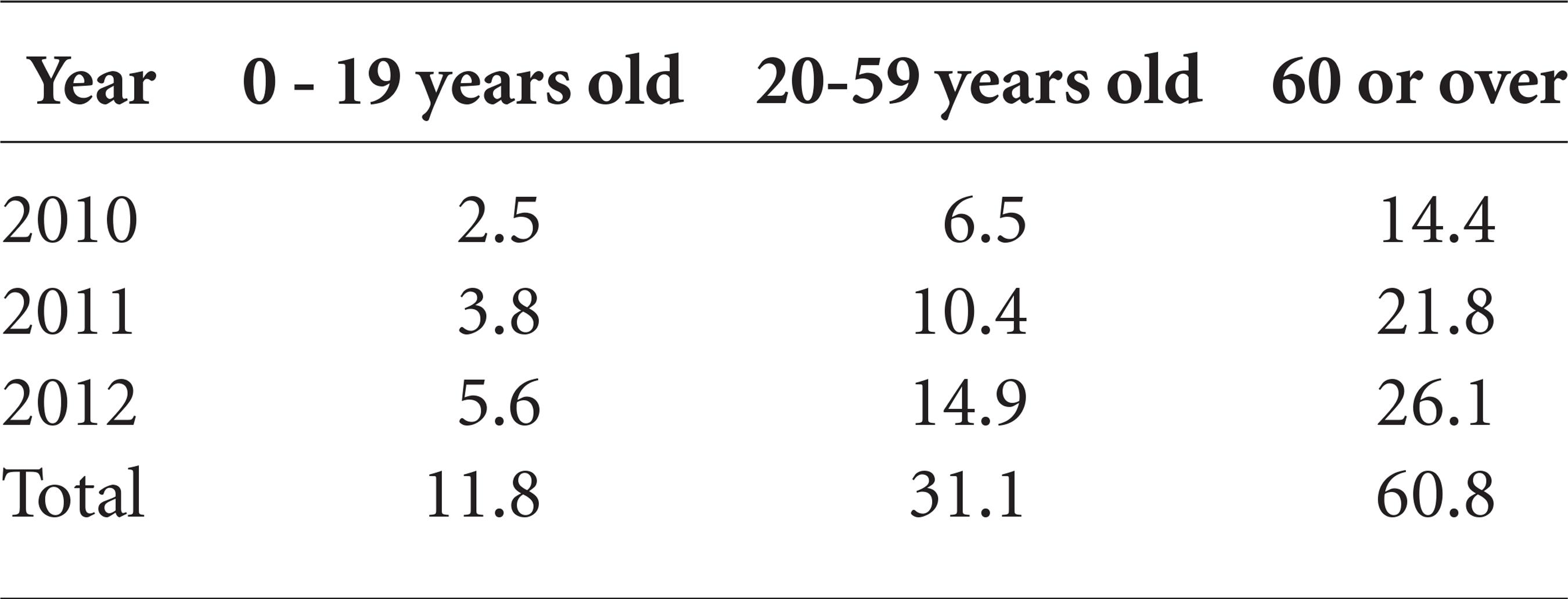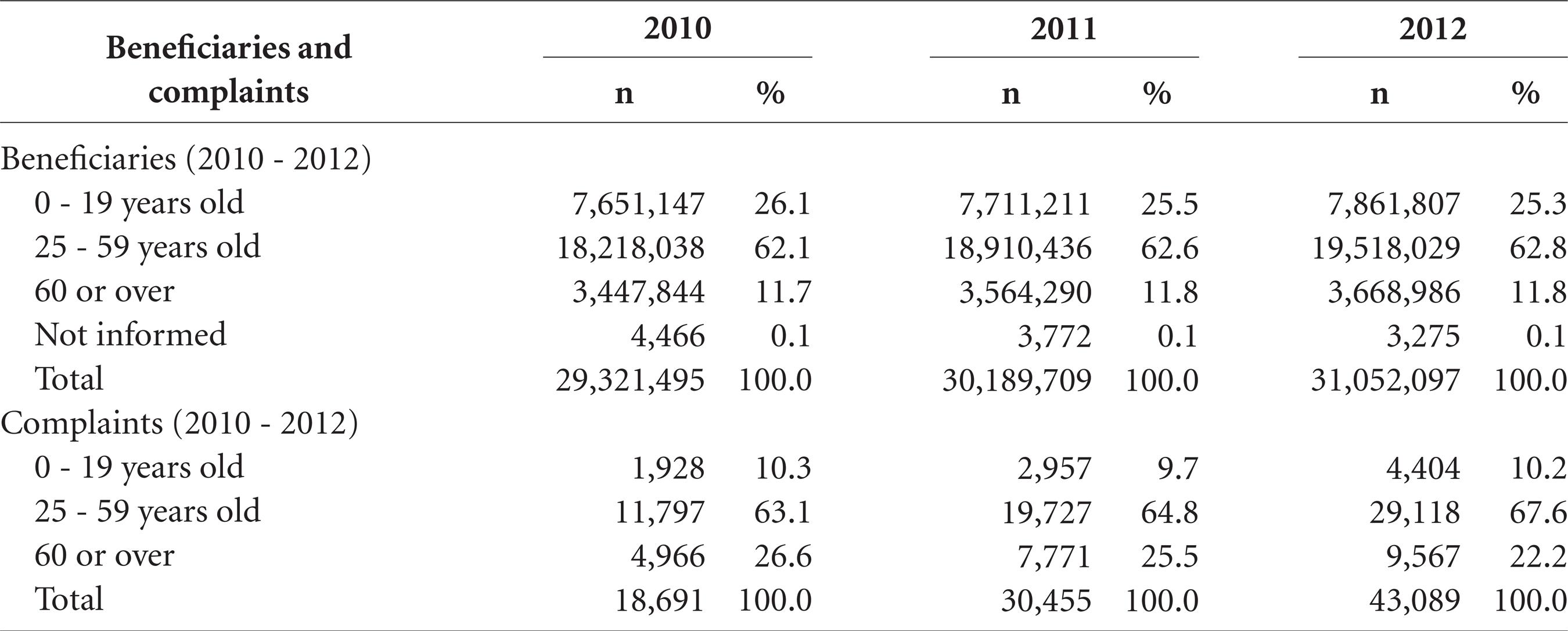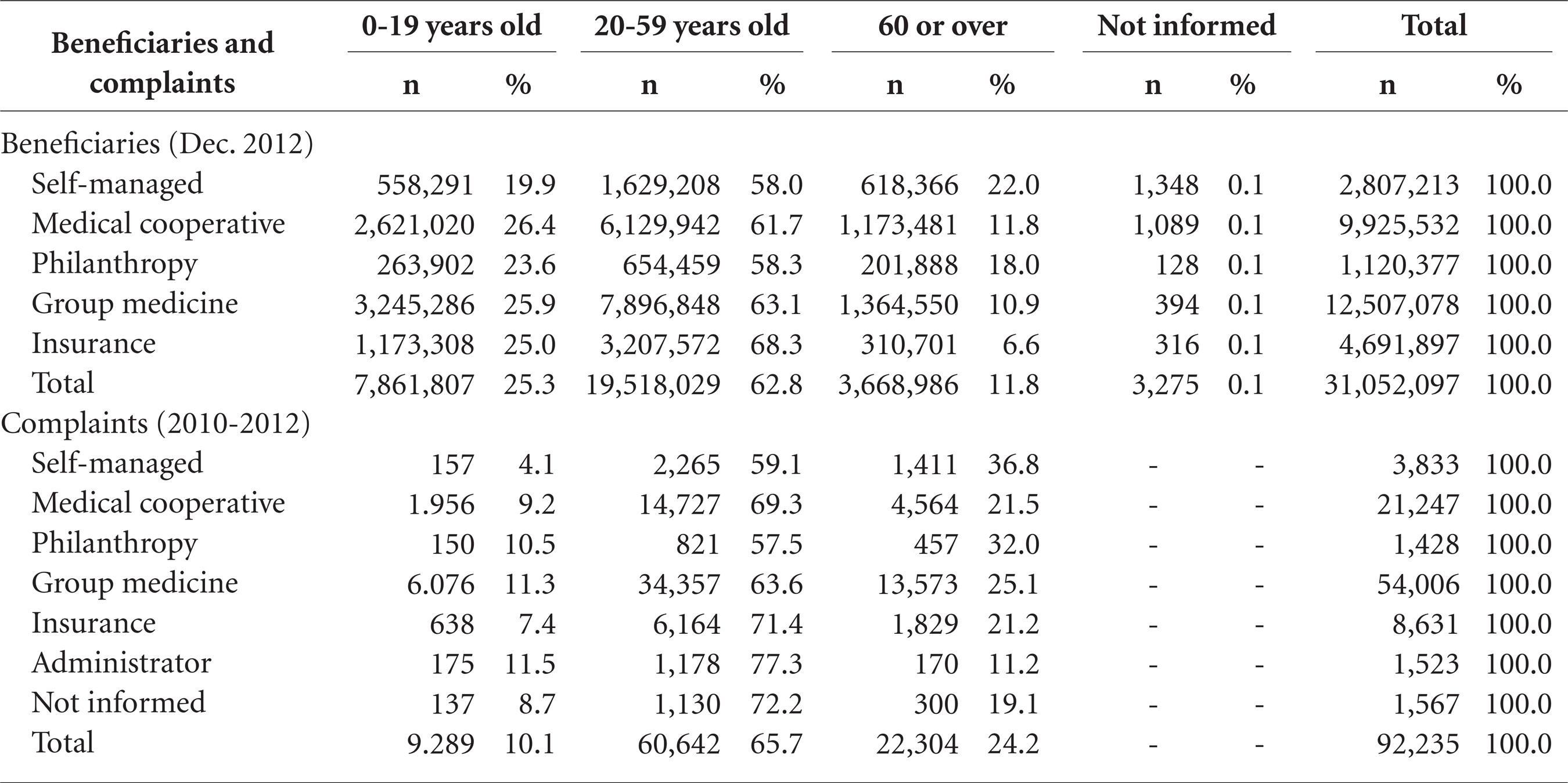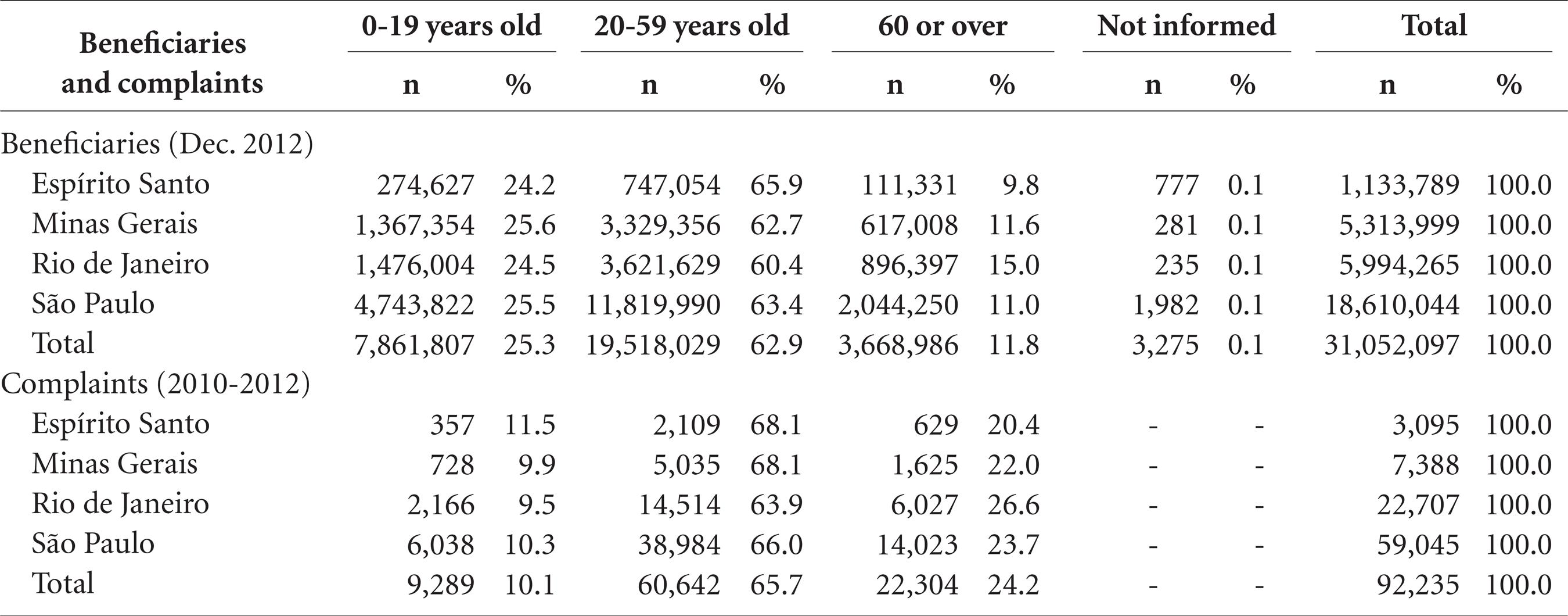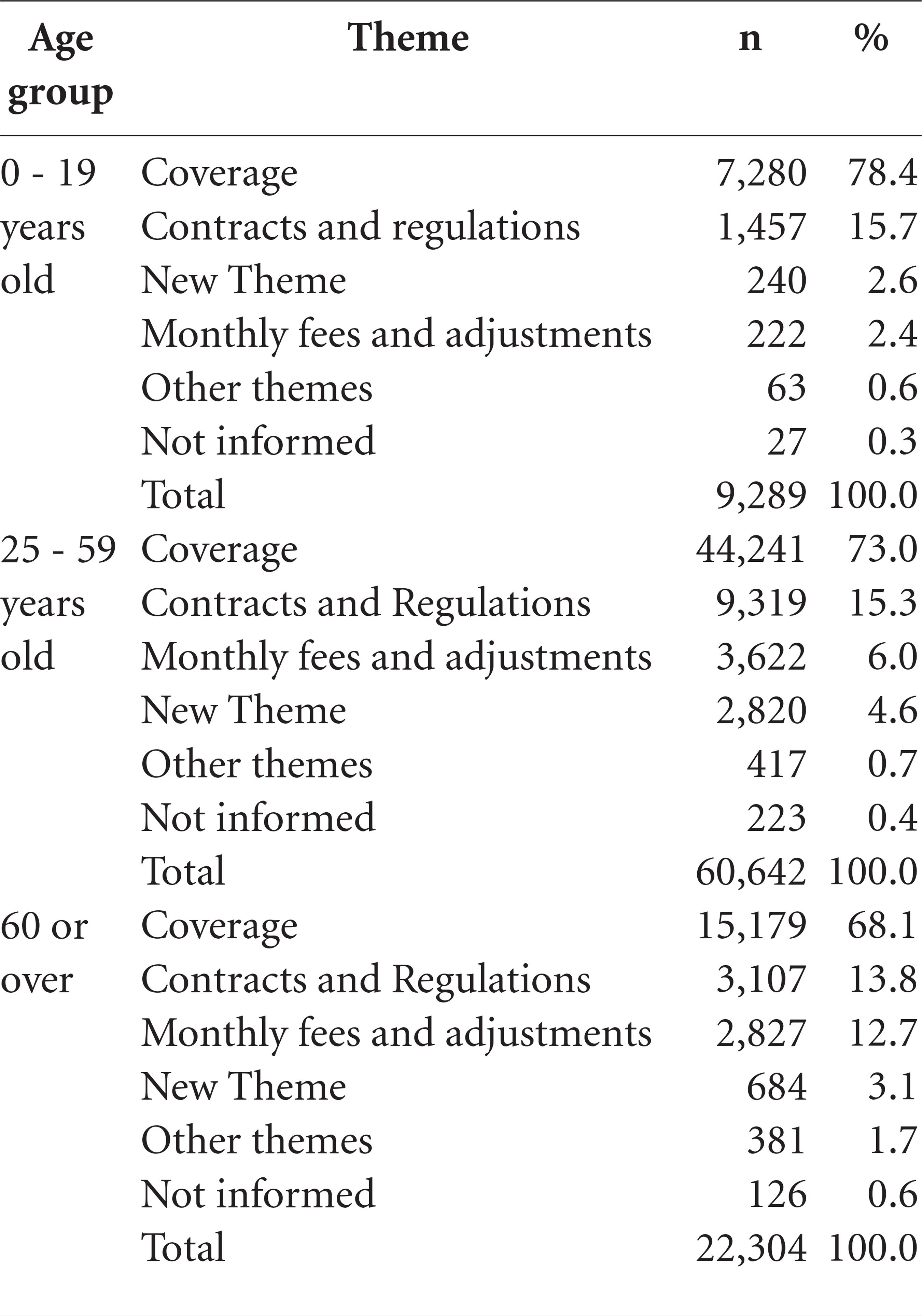Abstract
Although the Unified Healthcare System provides universal coverage, about 25% of the population in Brazil has some form of private healthcare. Considering that the population is aging, the prevalence of chronic diseases and the high costs associated with healthcare, the goal of this study is to assess if the barriers to access and use of the services offered by healthcare plans, expressed as beneficiary complaints, have a greater impact on the elderly than on adults and children. Transverse, exploratory study using a quantitative descriptive approach and secondary data provided by the ANS (the National Regulatory Agency for Private Health Insurance and Plans). This study analyzed complaints filed with the ANS by beneficiaries in the Southeast of Brazil between 2010 and 2012. The study population corresponded to 92,235 complaints. The elderly filed proportionately more complaints (60.8 vs. 25.5 complaints per 10 thousand beneficiaries). The most frequent (68.1%) complaints by the elderly were related to coverage. The results reinforce the idea that the organizational elements of private healthcare plans affect especially those groups most likely to use healthcare plans.
Healthcare system; Supplemental Health; Elderly; Healthcare Plans; Service coverage
Introduction
Although Brazilians have a constitutional right to a universal public healthcare system, government healthcare policies are responsible for the creation, consolidation and growth of private healthcare in Brazil. The State made polarized policy decisions. On the one hand, it provided the constitutional right to universal health on an equal basis to all citizens, but on the other, it contributed to consolidating a private healthcare industry that is economically important. The structure of the supplemental healthcare sector is the result of historical relationships between the State and private healthcare. Over time, the Brazilian healthcare industry has had varied public/private compositions, depending on the prevailing healthcare policy. Yet State and private services have always intersected, and some services provided by private providers are heavily funded by the government11. Cecílio LCO, Aciole GG, Meneses CS, Iriart CB. A saúde suplementar na perspectiva da microrregulação. In: Brasil. Ministério da Saúde (MS). Agência Nacional de Saúde Suplementar. Duas Faces da Mesma Moeda: microrregulação e modelos assistenciais na saúde suplementar. Rio de Janeiro: MS; 2005. p. 63-74..
Therefore, this is a universal and integrated system, with a private system that is partially funded by services purchased by the State, and a segment of healthcare plan providers that have significant direct and indirect state incentive, constituting a barrier to universality and equal use of healthcare services22. Santos IS, Ugá MAD, Porto SM. O mix público-privado no Sistema de Saúde Brasileiro: financiamento, oferta e utilização de serviços de saúde.Cien Saude Colet 2008; 13(5):1431-1440.,33. Fundação Oswaldo Cruz (Fiocruz). A saúde no Brasil em 2030: diretrizes para a prospecção estratégica do sistema de saúde brasileiro. Rio de Janeiro: Fiocruz/Ipea/Ministério da Saúde/Secretaria de Assuntos Estratégicos da Presidência da República; 2012. [acessado 2013 set 11]. Disponível em http://www.fiocruz.br/editora/media/Saude_Brasil_2030.pdf
http://www.fiocruz.br/editora/media/Saud... .
Added to this, we have the issue of an aging population. In most of the developed world, population aging was a gradual process that took place over decades and generations of almost constant socioeconomic growth44. Kalache A, Keller I. The greying world: a challenge for the 21st century. Science Progress 2000; 83(1):33-54.. In Brazil, aging is an accelerated process. IBGE (the Brazilian Institute for Geography and Statistics) data shows that in 1960, the elderly made up 4.8% of the population, or about 3 million individuals. Fifty years later, the IBGE census showed 20.6 million elderly, or 10.7% of the population55. Instituto Brasileiro de Geografia e Estatística, Diretoria de Pesquisas. Censo demográfico, 2010. Rio de Janeiro: IBGE; 2011.. Estimates indicate that by 2030 there will be 40.5 million elderly in Brazil, or 18.7% of the population. By 2050, the elderly will make up close to 29% of this country’s population66. Instituto Brasileiro de Geografia e Estatística (IBGE).Indicadores sociodemográficos e de saúde no Brasil 2009. Rio de Janeiro: IBGE; 2009..
Given the situation of demographic transition, which will result in a higher proportion of elderly in Brazil and the world, the impact of the aging population on the higher costs of healthcare is being discussed. In Brazil, over 25% of the population has some type of private healthcare plan, and 11% of them are 60 years of age or older77. Agência Nacional de Saúde Suplementar. Caderno de informação da saúde suplementar: beneficiários, operadoras e planos. Rio de Janeiro: Agência Nacional de Saúde Suplementar; 2013.. This is a population group with a range of chronic diseases, and thus more likely to use healthcare services, and there is a greater risk that they will require more intensive and thus more expensive care.
The combination of demographic transition and increased use of healthcare services by the elderly results in a projected increase in demand for services and spending, which in turn has caused concern regarding the sustainability of healthcare services88. Spillman BC, Lubitz J. The effect of longevity on spending for acute and long-term care. N Engl J Med 2000; 342(19):1409-1415.
9. Polder JJ, Bonneux L, Meerding WJ, Van der Maas PJ. Age-specific increases in health care costs. Eur J Public Health 2002; 12(1):57-62.-1010. Bains M. Projecting Future Needs: Long-term Projections of Public Expenditure on Health and Long-term Care for EU Member States. In: OECD.A Disease-based Comparison of Health Systems: What is Best and at What Cost? Paris: OECD Publishing; 2003. p. 145-161.. Given this scenario, studies on the pattern of use of healthcare services by the elderly show that they use these services more, and that the elderly account for a large share of hospitalization spending1111. Nunes A. O envelhecimento populacional e as despesas do Sistema Único de Saúde. In: Camarano AA, organizador. Os novos idosos brasileiros. Muito além dos 60? Rio de Janeiro: Instituto de Pesquisa Econômica Aplicada; 2004. p. 427-450.
12. Louvison MCP, Lebrão ML, Duarte YAO, Santos JLF, Malik AM, Almeida ES. Desigualdades no uso e acesso aos serviços de saúde entre idosos do município de São Paulo. Rev Saude Publica 2008; 42(4):733-740.
13. Lima-Costa MFF, Guerra HL, Barreto SM, Guimarães RM. Diagnóstico da situação de saúde da população idosa brasileira: um estudo da mortalidade e das internações hospitalares públicas. Informe Epidemiológico SUS2000; 23-41.
14. Peixoto SV, Giatti L, Afradique ME, Lima-Costa MFF. Custo das internações hospitalares entre idosos brasileiros no âmbito do Sistema Único de Saúde. Epidemiol Serv Saúde 2004; 13(4):239-246.
15. Berenstein CK, Wajnman S. Efeitos da estrutura etária nos gastos com internação no Sistema Único de Saúde: uma análise de decomposição para duas áreas metropolitanas brasileiras. Cad Saude Publica 2008; 24(10):2301-2313.-1616. Kanamura AH, Viana ALD. Gastos elevados em plano privado de saúde: com quem e em quê. Rev Saude Publica 2007; 41(5):814-820.. However, some authors question if the elderly are really the major source of higher healthcare system expenses. Reinhardt1717. Reinhardt UE. Does the Aging of the Population Really Drive the Demand for Health Care? Health Affairs 2003; 22(6):27-39. believes that the key factors influencing progressive growth of healthcare spending in the United States are related more to the use of new technologies, increased sector remuneration and asymmetric market distribution, giving healthcare providers more bargaining power to set values and prices.
Expansion of the private healthcare sector in Brazil has made this a consumer good. For most private healthcare companies, profitability includes risk selection, which naturally excludes the higher risk consumers, in particular the chronically ill and the elderly1818. Ocké-reis CO. SUS: o desafio de ser único. Rio de Janeiro: Editora Fiocruz; 2012.. When it comes to risk selection, it is fair to say that the elderly are not desired by healthcare plan operators, as they have more chronic diseases, use the services more and more often, and are more likely to require very costly treatments in the final years of their life.
In light of this, one recognizes that the relationship between the elderly and healthcare operators is a source of considerable tension. The elderly have problems purchasing healthcare, due to either sales strategies or difficulties or constraints imposed, such as requiring medical reports or qualified interviews. There are also regulating mechanisms such as requirements for authorizations or analysis of medical requests that make it harder to use the system. Although these constraints affect all groups, one may assume that they have a greater impact on the older population or on people with diseases whose treatment requires intense the use of expensive technologies. Add to that the impact of adjustments to the monthly fee, which for older patients can be twice the cost of the same plan for younger people, and in some cases the elderly are just unable to keep up their payments and migrate to the SUS.
In addition to selecting clients and risks, operators use all of the mechanisms allowed in supplemental healthcare regulations to control demand and use of services1919. Brasil. Resolução do Conselho de Saúde Suplementar. CONSU nº 8, de 3 de novembro de 1998. Dispõe sobre mecanismos de regulação nos Planos e Seguros Privados de Assistência à Saúde. Diário Oficial da União 1998; 4 nov.. In Brazil, managed care is based on controlling physician actions in the search for a better cost/effectiveness ratio and the rational use of services and inputs for each treatment2020. Aciole GG, Malta DC, Cecílio LCO, Jorge AO. Reflexões sobre o trabalho médico na Saúde Suplementar. In: Brasil. Ministério da Saúde (MS). Agência Nacional de Saúde Suplementar. Duas Faces da Mesma Moeda: microrregulação e modelos assistenciais na saúde suplementar. Rio de Janeiro: MS; 2005. p. 203-222.. However, the range of mechanisms applied by healthcare plan operators limits not only those services that are unnecessary, but also those that are necessary.
It would be reasonable to assume that this micro-regulation is exercised by operators more frequently with patients or groups at a higher risk of increasing the claims ratio. This mechanism to limit access creates dissatisfaction among beneficiaries when a given procedure is medically indicated, yet they face denials, postponements or outright refusal by the healthcare plan2121. Machado JRO. Negativas de cobertura pelas operadoras de planos de saúde: análise das denúncias de beneficiários encaminhadas à Agência Nacional de Saúde Suplementar (ANS) [dissertação]. Rio de Janeiro: Fiocruz; 2011.. The main reasons for dissatisfaction with healthcare plans are related to the delay in scheduling office visits, restrictions imposed on treatments, services and tests, and price adjustments as a function of age and geographic coverage2222. Gerschman S, Veiga L, Guimarães C, Ugá MAD, Portela MC, Vasconcellos MM, Barbosa PR, Lima SML. Estudo de satisfação dos beneficiários de planos de saúde dos hospitais filantrópicos. Cien Saude Colet2007; 12(2):487-500..
All of these together lead one to expect that the dissatisfaction of the elderly with such bad practices would be reflected in complaints made to the ANS. Regardless of whether or not a given complaint actually infringes supplemental health legislation, the complaint originates from an impasse, a dissatisfaction arising from a point of conflict between the healthcare plan and the beneficiary. Recognition of the field of tension is important to signal a problem that will only tend to get worse as the elderly become an increasing share of the population in Brazil.
Thus, the goal of this study is to check if the barriers to use and access to healthcare services expressed in the complaints filed with the ANS by beneficiaries in the Southeast of Brazil, between 2010 and 2012, affect the elderly in a greater way.
Methodology
The universe of this study are complaints filed with the ANS between 2010 and 2012 by beneficiaries residing in the states of Southeastern Brazil. The choice of Southeast states is justified by the high concentration of private healthcare plan owners in the region. In December 2012, a total of 48,695,327 people were covered by medical-hospital healthcare plans in Brazil, 31,052,097, or 63.8% of whom lived in the Southeast. In Espírito Santo, Rio de Janeiro and São Paulo, over 30% of the general population is has some form of coverage2323. Agência Nacional de Saúde Suplementar. ANS Tabnet. [acessado 2013 maio 10]. Disponível em: http://www.ans.gov.br/anstabnet/
http://www.ans.gov.br/anstabnet/... .
The main source of information was the SIF (Integrated Oversight System) database, which records all of the complaints filed with the ANS. This source dates back to the very creation of the ANS. According to Law 9,961, ANS responsibilities include overseeing the activities of private healthcare plan operators2424. Brasil. Lei n.º 9.961, de 28 de janeiro de 2000. Cria a Agência Nacional de Saúde Suplementar - ANS e dá outras providências. Diário Oficial da União 2000; 29 jan.. The consumer service center, known as Disque ANS, was created in 2001, soon after the agency itself. Beneficiaries may use Disque ANS to file a complaint against the healthcare plan operator. If the problem is not resolved, and there is any indication that supplemental health legislation is not being followed, an administrative case will be open to investigate the situation. If the investigation reveals that the law is being broken, administrative sanctions may be imposed on the operator in the form of a fine.
The data in the database used for this analysis was taken from the SIF on 17 April 2013, limited to complaints filed in 2010, 2011 and 2012. Of the 106,037 cases, those excluding beneficiary DOB, duplicate complaints filed by the same beneficiary and those regarding dental operators or cooperatives were excluded. The final universe for this analysis was made up of 92,235 entries.
Of the variables available in the system, we analyzed:
Year of reference - This will allow us to track number of complaints over time. It was used to describe the share of complaints by age group.
Type of contract - Describes the link between the beneficiary and the operator - whether an individual or group plan, whether a subscription or a group corporate plan.
Plan date - This shows if the healthcare plan of the beneficiary filing a complaint predates Law 9,656 of 2 January 1999, which regulates the private healthcare plan industry in Brazil. Plans subscribed to after 1999 are duly regulated by this law. If the beneficiary subscribed to a plan prior to this date it is not regulated, and coverage, adjustments and other contractual clauses do not fall under this law.
Type of Operator - Administrator, self-managed, medical cooperative, philanthropy, group medicine or insurance. Complaints filed with group dental plans and dental cooperatives were excluded from this analysis.
State - The state of residence of the beneficiary, used to compare possible regional differences.
Theme - The themes listed in the complaints filed and used in this study have been placed into the SIF theme tree. The most important themes for this study are those resulting from the relationship between beneficiary and operator. These are coverage, contracts & regulations, monthly fees and fee adjustments. Complaints on topics that do not fit any of the pre-definedDisque ANS themes are considered “New Themes”. Regulatory issues involving economic-financial aspects, information that must be submitted to the ANS and transfer of customer portfolios between operators are considered “Other Themes”.
We developed the following indicators to analyze the complaints:
- Complaints as a percentage of all complaints filed between 210 and 2012, calculated as “# of complaints/total complaints times 100”. These were grouped into three age groups: 0 to 19 years, 20 to 59 years, 60 or over.
- Percent beneficiaries (# of beneficiaries/total beneficiaries times 100). This calculation used the number of beneficiaries registered in the ANS Beneficiary Information System in December 2012, taken from ANS-Tabnet in May 2013. These were grouped into three age groups: 0 to 19 years; 20 to 59 years; 60 or over. It is worth pointing out that there was no age information for 3,275 beneficiaries. Although these cases were not included in the specific indicators, they have been described in the tables.
- Ratio of complaints per beneficiary by age group, expressed using the formula “# of complaints/# of beneficiaries per 10,000”. This ratio expresses complaints per 10,000 beneficiaries and measures the extent to which the elderly complain compared to other age groups.
Results
Of the 92,235 complaints analyzed, the elderly, which account for 11.8% total beneficiaries, were responsible for 24.2% of the complaints filed with the ANS (Table 1). The complaint ratio for the three years analyzed was 60.8/10,000 elderly beneficiaries, compared to 31.1/10,000 for beneficiaries aged 20 to 59. In other words, the elderly complain almost twice as much as other adults (Table 2). Among the elderly, the number of complaints increases with age: 57.9/10,000 beneficiaries between 65 and 69, compared to 63.9/10,000 beneficiaries between 74 and 79.
The annual number of complaints increased 130.5% in the period, going from 18 thousand to over 40 thousand. The number of beneficiaries grew only 5.9% in this period, from about 29 million to 31 million. In every year, the elderly complained more than other beneficiaries. The number of complaints filed by beneficiaries aged 20 to 59 increased faster (146.8%) than those filed by beneficiaries aged 60 or over (92%) (Table 3). Despite a proportional reduction in the number of complaints filed by the elderly, their ratio was highest every year and increased progressively, from 14.4/10,000 in 2010 to 26.1/10,000 beneficiaries in 2012 (Table 2).
Although only 19.1% of the beneficiaries in the Southeast had individual/family plans, this group filed a disproportionate number of complaints (48.2%). However, there may be problems with the quality of this data as not all beneficiaries were aware of the type of contract they were covered by. The proportion of “elderly beneficiaries” filing complaints was larger than the proportion of “beneficiary elderlies”, regardless of the nature of the coverage. The complaint ratio was always larger among the elderly, regardless of how healthcare coverage was contracted. The highest ratio was found in individual plans, with 105.8 complaints per 10,000 elderly beneficiaries.
Although there are no records of this, in 58.7% of the complaints, the share of complaints related to non-regulated plans was quite high (50.6%), in part due to the higher share of elderly beneficiaries of these contracts (25.2%) and the effectiveness of clauses limiting the use of the services provided or higher premium adjustments. These situations lead to conflicts between beneficiary and operator. Regardless of whether the contract was signed before or after the law regulating healthcare plans, the fact is that the elderly complain more. If we look only at complaints that include the date the contract was signed, the ratio is 24 for every 10,000 elderly beneficiaries, for regulated and non-regulated plans.
Group medicine had the highest share of complaints (58.6%). However, regardless of the type of plan operator, the incidence of complaints by elderly beneficiaries was always higher. An analysis of the complaint ratios shows that the highest incidence was found among the elderly beneficiaries, regardless of the type of operator. In group medicine, the complaint ratio was 99.5 per 10,000 beneficiaries, followed by health insurance with 58.9 complaints/10,000 beneficiaries. The lowest ratios were found in self-managed plans and philanthropies, both with about 22 complaints per 10,000 elderly beneficiaries (Table 4).
Of the Southeast states, São Paulo had 59.9% of the beneficiaries, who were responsible for 64% of the complaints. Minas Gerais on the other hand, had 17.1% of the beneficiaries who were responsible for only 8% of the complaints. In Southeast states the elderly complained more than beneficiaries in this age bracket. The highest complaint ratio was found in Rio de Janeiro (26.5%), which also has the largest percent of elderly beneficiaries (15.0%).
The complaint ratio for every state in the region was higher among elderly beneficiaries, with the lowest ratio in Minas Gerais - 26.3/10,000 beneficiaries in this age bracket. The complaint ratio in Rio de January and São Paulo was around 65/10,000 elderly beneficiaries (Table 5).
If we look at the reason for the complaints, we find that coverage was the primary reason (68%) (Table 6), reflecting issues of limited access for this population group imposed by healthcare plan operators. One must point out that among the elderly there is a high proportion of complaints against “monthly premiums and adjustments” (12.7%), while the incidence of such complaints among adults is only 6.0% (Table 6).
Discussion
This study attempted to determine the extent to which risk selection strategies and service cost saving measures adopted by healthcare plans affect the elderly, as reflected in complaints filed with the ANS. The importance of this discussion for the nation’s healthcare policy is related to the aging population and the State’s incentives for private healthcare. Private healthcare companies that sell coverage plans aim to maximize their profits, as would be expected. In the search for profits, it is likely that some groups will be more affected than others.
This study shows that compared to other age groups, the elderly file more complaints with the ANS, even though they are not the largest group of plan beneficiaries. This is cause for concern, as it is when they are older and more fragile that beneficiaries find barriers to accessing the services that should be provided to them. This finding would seem to reinforce the rationale that the organizational devices of private healthcare plans create access barriers and risk reduction strategies that affect primarily the groups more likely to use the services. In this study, we chose to look at the elderly, as they are more susceptible to restrictions on the use of healthcare services due to their inherent characteristics, such as the likelihood that they have a chronic disease and a pattern of increased use of healthcare services. However, adults and children are certainly also affected by these restrictions, in particular pregnant women and people with chronic diseases.
Although there is no data on which procedures are denied, which would require a manual analysis of each complaint, previous studies based on data on lawsuits and ANS complaints show that in general these are high-cost procedures2525. Scheffer M. Os planos de saúde nos tribunais: uma análise das ações judiciais movidas por clientes de planos de saúde, relacionados à negação de coberturas assistenciais no Estado de São Paulo[dissertação]. São Paulo: USP; 2006.
26. Alves DC, Bahia L, Barroso AF. O papel da Justiça nos planos e seguros de saúde no Brasil. Cad Saude Publica 2009; 25(2):270-290.-2727. Scheffer M. Coberturas assistenciais negadas pelos planos e seguros de saúde em ações julgadas pelo Tribunal de Justiça do estado de São Paulo.R. Dir. Sanitário 2013; 14(1):122-132..
This situations is illustrated by Scheffer2525. Scheffer M. Os planos de saúde nos tribunais: uma análise das ações judiciais movidas por clientes de planos de saúde, relacionados à negação de coberturas assistenciais no Estado de São Paulo[dissertação]. São Paulo: USP; 2006.: Coverage exclusions consistently reported or claimed by users show the imbalance and conflict that currently exists between operators, providers and clients. This shows that not even the supposed virtuous nature of free enterprise, nor the regulations in place are able to properly solve the problem, as it involves disparate interests and expectations.
Furthermore, the percent complaints filed by the elderly about the high cost of monthly premiums (12.7%) illustrates the impact of the high percent adjustments charged to people as they advance in age. This also constitutes an access barrier, as it makes it impossible for people to keep up their healthcare plans. Added to this is the difficulty migrating to different plans, as most operators do not offer individual healthcare plans.
This study found a number of limitations in terms of the data required for the intended analysis. Initially we found a number of incomplete complaints files. When analyzing the complaints we realized that a large number did not include the date of enrollment in the plan, and many mentioned “New Theme”, which is vague and likely used due to the inability to classify the complaint in one of the existing themes. The ANS must try to improve its theme tree for complaints to enable analyzing the reasons why beneficiaries file complaints, and to monitor operator conduct over time.
We were also unable to draw any conclusions about elderly people being denied enrollment in healthcare plans. The theme covering this would be “Contracts and Regulations”, which is far too broad. In this line, it would be interesting to further break down complaints, such as by mentioning the procedure generating the complaint, and the mechanism used to resolve the issue. This data would enable more complete analyses and monitoring for repeat incidents with operators.
We point out that the results submitted in this paper should be taken as the tip of the iceberg due to, for example, the inability to map cases where individuals had trouble enrolling in healthcare plans, and also because the data used was limited to voluntary complaints. Certainly there is other data regarding healthcare plan beneficiary complaints dispersed in other data system, such as the justice and consumer defense systems. There are also many situations where beneficiaries are able to solve their health problem by resorting to the SUS. A considerable number of people with healthcare plans also use the public health service22. Santos IS, Ugá MAD, Porto SM. O mix público-privado no Sistema de Saúde Brasileiro: financiamento, oferta e utilização de serviços de saúde.Cien Saude Colet 2008; 13(5):1431-1440.,2828. Porto SM, Ugá MAD, Moreira RS. Uma analise da utilização de serviços de saúde por sistema de financiamento: Brasil 1998-2008. Cien Saude Colet 2011; 16(9):3795-3806.
The findings of the present study, that the conflict of interest between healthcare plan operators and beneficiaries affects the elderly quite specifically, is very relevant for defining healthcare and regulatory policies for this sector. This is particularly the case in light of the challenges posed by population aging, with the associated morbidity profile, requiring reorganization and coordination of healthcare in Brazil, just as in other countries. From this point of view, the healthcare systems and the healthcare organization should prioritize preventive measures to keep people healthy, but at the same time try to integrate the healthcare network - outpatient clinics, emergency centers and hospitals - with social support services2929. Curry N, Ham C. Clinical and service Integration The route to improved outcomes. List Int J Integr Care 2012; 12:e199..
Given this challenge, paradoxically, the current model operators use to market healthcare by o is going in the opposite direction, where healthcare is driven primarily by financial aspects. This makes it difficult to make the right to health and healthcare compatible with private enterprise. Here Campos3030. Campos GWS. O público, o estatal e o particular nas políticas públicas de saúde. In: Heimann LS, Ibanhes LC, Barboza R. O público e o privado na saúde. São Paulo: Hucitec; 2005. p. 89-101. mentions that when healthcare becomes a competitive activity subject to the laws of free enterprise, private interests predominate, degrading the quality and efficiency of care, and responsibility.
This debate, along with other long-term challenges to healthcare in Brazil, must inevitably include a discussion of a new arrangement for supplemental health, including a review of the current compensation model, where providers are encouraged to work within a production rationale based on the number of procedures3131. Hernández-Quevedo C, Llano R, Mossialos E. Paying for integrated care: an overview. Euro health incorporating Euro Observer2013; 19(2):3-6..
If the State agenda privileges incentives to the private sector by waiving and reducing taxes, it must also be aware that these providers will always opt for the solution that brings in the most economic benefit. In itself this would justify an urgent intervention by the State, with a regulatory policy that preserves the rights of beneficiaries that chose to use private healthcare plans. Considering that it is the goal of the ANS to promote the defense of the public interest in supplemental healthcare, operator conduct must be closely monitored, including checks if healthcare plans are imposing restrictions and harming the health of their beneficiaries. This regulatory effort would require acting in several spheres, from mobilizing players and society through providing suitable and reliable information systems.
This discussion cannot exclude society in general. Those who today are able to pay for a more expensive healthcare plan, with a better network of accredited hospitals, and those who have plans through their employers feel they are “safe” and ignore or take no account of the public healthcare system. However, those who are today considered of low healthcare risk, will be elderly and retired someday, and more susceptible to the micro-regulation exercised by healthcare plans.
Acknowledgements
We would like to thank the ANS for facilitating access to the data analyzed; to CAPES for the stipend granted to Monica Martins for a post-doctoral period abroad.
References
- 1Cecílio LCO, Aciole GG, Meneses CS, Iriart CB. A saúde suplementar na perspectiva da microrregulação. In: Brasil. Ministério da Saúde (MS). Agência Nacional de Saúde Suplementar. Duas Faces da Mesma Moeda: microrregulação e modelos assistenciais na saúde suplementar Rio de Janeiro: MS; 2005. p. 63-74.
- 2Santos IS, Ugá MAD, Porto SM. O mix público-privado no Sistema de Saúde Brasileiro: financiamento, oferta e utilização de serviços de saúde.Cien Saude Colet 2008; 13(5):1431-1440.
- 3Fundação Oswaldo Cruz (Fiocruz). A saúde no Brasil em 2030: diretrizes para a prospecção estratégica do sistema de saúde brasileiro Rio de Janeiro: Fiocruz/Ipea/Ministério da Saúde/Secretaria de Assuntos Estratégicos da Presidência da República; 2012. [acessado 2013 set 11]. Disponível em http://www.fiocruz.br/editora/media/Saude_Brasil_2030.pdf
» http://www.fiocruz.br/editora/media/Saude_Brasil_2030.pdf - 4Kalache A, Keller I. The greying world: a challenge for the 21st century. Science Progress 2000; 83(1):33-54.
- 5Instituto Brasileiro de Geografia e Estatística, Diretoria de Pesquisas. Censo demográfico, 2010 Rio de Janeiro: IBGE; 2011.
- 6Instituto Brasileiro de Geografia e Estatística (IBGE).Indicadores sociodemográficos e de saúde no Brasil 2009 Rio de Janeiro: IBGE; 2009.
- 7Agência Nacional de Saúde Suplementar. Caderno de informação da saúde suplementar: beneficiários, operadoras e planos Rio de Janeiro: Agência Nacional de Saúde Suplementar; 2013.
- 8Spillman BC, Lubitz J. The effect of longevity on spending for acute and long-term care. N Engl J Med 2000; 342(19):1409-1415.
- 9Polder JJ, Bonneux L, Meerding WJ, Van der Maas PJ. Age-specific increases in health care costs. Eur J Public Health 2002; 12(1):57-62.
- 10Bains M. Projecting Future Needs: Long-term Projections of Public Expenditure on Health and Long-term Care for EU Member States. In: OECD.A Disease-based Comparison of Health Systems: What is Best and at What Cost? Paris: OECD Publishing; 2003. p. 145-161.
- 11Nunes A. O envelhecimento populacional e as despesas do Sistema Único de Saúde. In: Camarano AA, organizador. Os novos idosos brasileiros. Muito além dos 60? Rio de Janeiro: Instituto de Pesquisa Econômica Aplicada; 2004. p. 427-450.
- 12Louvison MCP, Lebrão ML, Duarte YAO, Santos JLF, Malik AM, Almeida ES. Desigualdades no uso e acesso aos serviços de saúde entre idosos do município de São Paulo. Rev Saude Publica 2008; 42(4):733-740.
- 13Lima-Costa MFF, Guerra HL, Barreto SM, Guimarães RM. Diagnóstico da situação de saúde da população idosa brasileira: um estudo da mortalidade e das internações hospitalares públicas. Informe Epidemiológico SUS2000; 23-41.
- 14Peixoto SV, Giatti L, Afradique ME, Lima-Costa MFF. Custo das internações hospitalares entre idosos brasileiros no âmbito do Sistema Único de Saúde. Epidemiol Serv Saúde 2004; 13(4):239-246.
- 15Berenstein CK, Wajnman S. Efeitos da estrutura etária nos gastos com internação no Sistema Único de Saúde: uma análise de decomposição para duas áreas metropolitanas brasileiras. Cad Saude Publica 2008; 24(10):2301-2313.
- 16Kanamura AH, Viana ALD. Gastos elevados em plano privado de saúde: com quem e em quê. Rev Saude Publica 2007; 41(5):814-820.
- 17Reinhardt UE. Does the Aging of the Population Really Drive the Demand for Health Care? Health Affairs 2003; 22(6):27-39.
- 18Ocké-reis CO. SUS: o desafio de ser único Rio de Janeiro: Editora Fiocruz; 2012.
- 19Brasil. Resolução do Conselho de Saúde Suplementar. CONSU nº 8, de 3 de novembro de 1998. Dispõe sobre mecanismos de regulação nos Planos e Seguros Privados de Assistência à Saúde. Diário Oficial da União 1998; 4 nov.
- 20Aciole GG, Malta DC, Cecílio LCO, Jorge AO. Reflexões sobre o trabalho médico na Saúde Suplementar. In: Brasil. Ministério da Saúde (MS). Agência Nacional de Saúde Suplementar. Duas Faces da Mesma Moeda: microrregulação e modelos assistenciais na saúde suplementar Rio de Janeiro: MS; 2005. p. 203-222.
- 21Machado JRO. Negativas de cobertura pelas operadoras de planos de saúde: análise das denúncias de beneficiários encaminhadas à Agência Nacional de Saúde Suplementar (ANS) [dissertação]. Rio de Janeiro: Fiocruz; 2011.
- 22Gerschman S, Veiga L, Guimarães C, Ugá MAD, Portela MC, Vasconcellos MM, Barbosa PR, Lima SML. Estudo de satisfação dos beneficiários de planos de saúde dos hospitais filantrópicos. Cien Saude Colet2007; 12(2):487-500.
- 23Agência Nacional de Saúde Suplementar. ANS Tabnet [acessado 2013 maio 10]. Disponível em: http://www.ans.gov.br/anstabnet/
» http://www.ans.gov.br/anstabnet/ - 24Brasil. Lei n.º 9.961, de 28 de janeiro de 2000. Cria a Agência Nacional de Saúde Suplementar - ANS e dá outras providências. Diário Oficial da União 2000; 29 jan.
- 25Scheffer M. Os planos de saúde nos tribunais: uma análise das ações judiciais movidas por clientes de planos de saúde, relacionados à negação de coberturas assistenciais no Estado de São Paulo[dissertação]. São Paulo: USP; 2006.
- 26Alves DC, Bahia L, Barroso AF. O papel da Justiça nos planos e seguros de saúde no Brasil. Cad Saude Publica 2009; 25(2):270-290.
- 27Scheffer M. Coberturas assistenciais negadas pelos planos e seguros de saúde em ações julgadas pelo Tribunal de Justiça do estado de São Paulo.R. Dir. Sanitário 2013; 14(1):122-132.
- 28Porto SM, Ugá MAD, Moreira RS. Uma analise da utilização de serviços de saúde por sistema de financiamento: Brasil 1998-2008. Cien Saude Colet 2011; 16(9):3795-3806.
- 29Curry N, Ham C. Clinical and service Integration The route to improved outcomes. List Int J Integr Care 2012; 12:e199.
- 30Campos GWS. O público, o estatal e o particular nas políticas públicas de saúde. In: Heimann LS, Ibanhes LC, Barboza R. O público e o privado na saúde São Paulo: Hucitec; 2005. p. 89-101.
- 31Hernández-Quevedo C, Llano R, Mossialos E. Paying for integrated care: an overview. Euro health incorporating Euro Observer2013; 19(2):3-6.
Publication Dates
- Publication in this collection
Dec 2015
History
- Received
04 Aug 2014 - Accepted
26 Nov 2014 - Reviewed
28 Nov 2014


